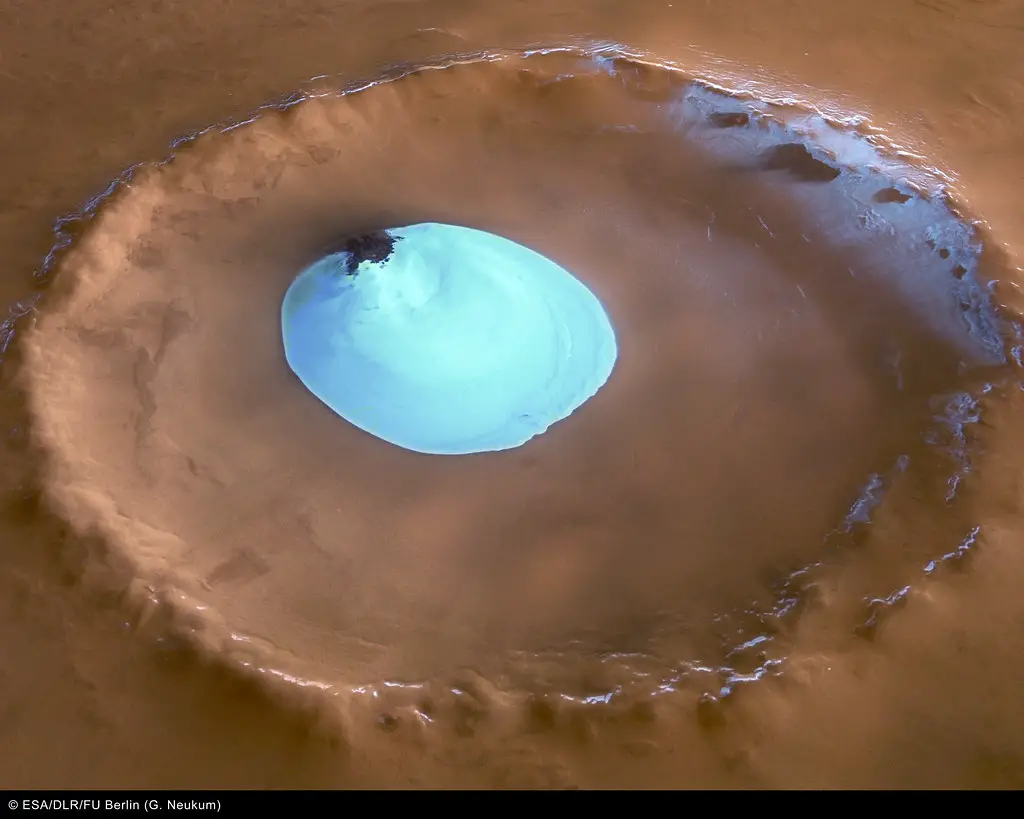NASA has recently conducted some astounding and ground-breaking research in an effort to learn more about the red planet Mars. Large amounts of water ice that were hidden beneath the Martian surface have been accidentally discovered. This startling discovery could completely change how we view and handle interplanetary travel, potentially reshaping the course of future human expeditions to Mars.
Notably, other reliable sources have confirmed this significant discovery. Contrary to popular belief, it spreads not just to the northern parts of the red planet but also to the mid-latitudes and, astoundingly, the equatorial regions.
This discovery throws open a wide range of opportunities and advances our understanding of Mars’ mysterious nature, bringing us one step closer to realizing the planet may be able to support human colonization efforts in the future. Mars pulls us with an alluring attraction as we continue to explore the mysteries of the universe, promising to unlock new frontiers for human exploration and unveil its secrets.
Unearthing the Martian Ice
The Mars global maps offer significant and previously unheard-of insights on the distribution and composition of water ice on the mysterious Red Planet. They were created using state-of-the-art technology and sophisticated imaging techniques. These painstakingly created maps, which were painstakingly assembled from an abundance of data gathered by multiple Mars missions, reveal an amazing discovery: water ice is not only present on Mars, but it is also most likely hidden within the top three feet (one meter) of the Martian surface, mysteriously close but mysteriously hidden.
That’s not all, though. With its tenacious and unyielding exploration efforts, the Mars Express orbiter has achieved an incredible discovery. It has discovered a sizable amount of water ice beneath Mars’ equator, indicating that the planet’s past may have been entwined with the existence of a shallow ocean. This idea captivates the imagination and poses a plethora of questions regarding the planet’s past and possible habitability.
These ground-breaking discoveries, made possible by NASA’s unwavering search for knowledge and ongoing technological developments, not only expand our comprehension of the Red Planet but also reveal its mysterious mysteries, which have long fascinated scientists and space lovers. One astounding finding at a time, we are revealing the secrets of Mars and laying the groundwork for future expeditions as we delve further into these breathtaking mysteries.
The Significance of the Discovery
This important discovery has enormous implications for human spaceflight. An essential resource for keeping astronauts alive on Mars, is essential to their survival. Water will be essential to their survival in the hostile Martian environment, not only for drinking but also for producing food and making fuel. NASA may strategically arrange landing sites for manned missions in the future by precisely pinpointing the locations of this ice on Mars, ensuring easy access to this priceless resource.
Furthermore, the existence of water ice on Mars offers a unique chance to investigate the planet’s past climate. It provides a rare window for scientists to understand how the warm, humid planet Mars changed over time to become the chilly, arid world we see today. Studying this transition can yield important insights into the planet’s past and make a substantial contribution to our understanding of planetary evolution as a whole. It also piques our interest in the possibilities of habitability and life elsewhere in the universe, possibly beyond Earth.
Looking Forward
The scientific community and beyond are buzzing with excitement at the recent finding of buried water ice on Mars, which opens up a world of possibilities for space travel in the future. This ground-breaking discovery may hold the key to discovering the mysteries of Martian life, in addition to providing insight into the planet’s enigmatic past.
Careful mapping and in-depth analysis of these ice deposits will surely give us priceless insights on the planet’s geological past and its potential to support life as we know it, as we continue our exploration of Mars. We are drawn to explore space in a new way, driven by the urge to know what lies beneath the surface of Mars and the alluring possibility of finding more hints about the planet’s mysterious past.
Leading this incredible adventure, NASA now has the critical responsibility of carefully selecting the best landing locations for their next missions so they can reach these hidden ice riches. If this mission is carried out successfully, it may help to solve some of the riddles surrounding Mars and our neighboring planet.
This groundbreaking discovery lends even more credence to the long-held theory that the Martian polar ice caps are visible through telescopes from Earth. However, thanks to NASA’s tireless efforts and ground-breaking exploration missions, the real extent and distribution of this ice have just lately come to light.
We are on the cusp of a new age in space exploration as humanity continues to search for answers and insights about Mars. Our excitement with the Red Planet grows with every new finding, which motivates us to explore its hidden treasures and maybe even find evidence of extraterrestrial life.
To sum up, the finding of water ice on Mars represents a substantial advancement in our knowledge of the red planet. It not only gets us one step closer to the prospect of sending humans to Mars, but it also creates fresh opportunities for studying the planet’s past and possible habitability.
Sources
- Distribution of Buried Ice on Mars – JPL
- Water ice buried at Mars’ equator – Space.com
- NASA’s Treasure Map for Water Ice on Mars – NASA
- New map of ice on Mars – Space.com
- HiRISE Views a Mars Impact Crater – JPL
- Best places to find ice on Mars – EarthSky
- Water ice – Mars Education – Arizona State University
![]()
